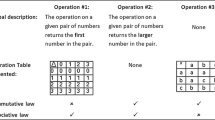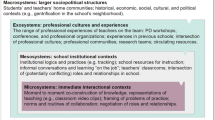Abstract
This study compares web usage data with interviews from 41 participants, who are members of an online professional development site called the Everyday Mathematics Virtual Learning Community (VLC), to explore how elementary school teachers learn from classroom video. Web usage data reveal that the commentary surrounding video posted to the VLC is sparse and surface level, possibly indicating a lack of serious attention to the videos. Interview data, however, indicate that participants felt they learned from this resource. Participants reported that the videos provided them with the opportunity to view and reflect on model lessons, plan curricula, and consider student thinking, among other learning outcomes. Participants also identified key factors that prevented them from posting comments to the site to convey their learning. These results can be used to understand not only how teachers perceive their own learning from classroom video, but also to redesign online professional development experiences to promote expression of that learning.


Similar content being viewed by others
Notes
Throughout this paper, we use the term website-use data to refer to both quantitative web analytics and qualitative posted online commentary. We use the term user behavior to refer to participants’ user profiles derived from web analytics and online commentary.
We note that the reasons for not commenting could range from those that are personal (e.g., shyness) or structural (e.g., aspects of the website’s design may not effectively communicate to users the goal of commenting on video). We approached this question inductively and did not assume users were aware that commenting on video was an option and also a goal of the website.
During theoretical sampling, we observed that for some participants their self-identified user behavior conflicted with their user-behavior profile, thus calling into question the need to find participants to fit the predetermined categories. We address these divergent data in the Results section.
We discuss how Justine’s depth of commentary relates to her perceptions of learning in the Points of Convergence and Divergence subsection.
This participant only posted an online comment once, and in her interview, did not recall this event.
Note: This statement excludes the 1 video-user deep commenter who did not remember ever posting a comment and cited that she Did Not Know this was an option.
References
Ball, D. L., & Cohen, D. K. (1999). Developing practice, developing practitioners. In L. Darling-Hammond & G. Sykes (Eds.), Teaching as the learning profession: Handbook of policy and practice (pp. 3–32). San Francisco: Jossey-Bass.
Barab, S. A., MaKinster, J. G., Moore, J. A., & Cunningham, D. J. (2001). Designing and building an on-line community: The struggle to support sociability in the Inquiry Learning Forum. Educational Technology Research and Development, 49, 71–96.
Bates, M. S., Phalen, L., & Moran, C. G. (2016a). If you build it, will they reflect? Examining teachers' use of an online video-based learning website. Teaching and Teacher Education, 58, 17–27.
Bates, M. S., Phalen, L., & Moran, C. (2016b). Online professional development: A primer. Phi Delta Kappan, 97(5), 70–73.
Beilstein, S. O., Perry, M., & Bates, M. S. (2017). Prompting meaningful analysis from pre-service teachers using elementary mathematics video vignettes. Teaching and Teacher Education, 63, 285–295.
Borko, H. (2004). Professional development and teacher learning: Mapping the terrain. Educational Researcher, 33(8), 3–15.
Borko, H., Jacobs, J., Eiteljorg, E., & Pittman, M. E. (2008). Video as a tool for fostering productive discussions in mathematics professional development. Teaching and Teacher Education, 24, 417–436.
Borko, H., Whitcomb, J., & Liston, D. (2009). Wicked problems and other thoughts on issues of technology and teacher learning. Journal of Teacher Education, 60, 3–7.
Brophy, J. (2004). Introduction. In J. Brophy (Ed.), Advances in research on teaching: Vol. 10. Using video in teacher education (p. ix–xxiv). Oxford, UK: Elsevier.
Caracelli, V. J., & Greene, J. C. (1993). Data analysis strategies for mixed-method evaluation designs. Educational Evaluation and Policy Analysis, 15, 195–207.
Chokshi, S., & Fernandez, C. (2004). Challenges to importing Japanese lesson study: Concerns, misconceptions, and nuances. Phi Delta Kappan, 85, 520–525.
Chval, K. B., Lannin, J. K., Arbaugh, F., & Bowzer, A. D. (2009). Videos and prospective teachers. Teaching Children Mathematics, 16(2), 98–105.
Cohen, J. (1960). A coefficient of agreement for nominal scales. Educational and Psychological Measurement, 20, 37–46.
Coles, A. (2013). Using video for professional development: The role of the discussion facilitator. Journal of Mathematics Teacher Education, 16, 165–184.
Community for Advancing Discovery Research in Education. (2017). Emerging design principles for online and blended teacher professional development in K-12 STEM education. Waltham, MA: Education Development Center, Inc. Retrieved from http://cadrek12.org/resources/emerging-design-principles-online-and-blendedteacher-professional-development-k-12-stem.
Corbin, J. M., & Strauss, A. (1990). Grounded theory research: Procedures, canons, and evaluative criteria. Qualitative Sociology, 13(1), 3–21.
Corbin, J., & Strauss, A. (2008). Basics of qualitative research (3rd ed.): Techniques and procedures for developing grounded theory. Thousand Oaks, CA: Sage.
Davis, E. A., & Krajcik, J. S. (2005). Designing educative curriculum materials to promote teacher learning. Educational Research, 34(3), 3–14.
De Carvalho Borba, M., & Llinares, S. (2012). Online mathematics teacher education: Overview of an emergent field of research. ZDM Mathematics Education, 44, 697–704.
Dede, C., Ketelhut, D. J., Whitehouse, P., Breit, L., & McCloskey, E. M. (2009). A research agenda for online teacher professional development. Journal of Teacher Education, 60, 8–19.
Desimone, L. M., Porter, A. C., Garet, M. S., Yoon, K. S., & Birman, B. F. (2002). Effects of professional development on teachers’ instruction: Results from a three-year longitudinal study. Educational Evaluation and Policy Analysis, 24, 81–112.
Farooq, U., Schank, P., Harris, A., Fusco, J., & Schlager, M. (2007). Sustaining a community computing infrastructure for online teacher professional development: A case study of designing Tapped In. Computer Supported Cooperative Work (CSCW), 16, 397–429.
Garet, M. S., Porter, A. C., Desimone, L., Birman, B. F., & Yoon, K. S. (2001). What makes professional development effective? Results from a national sample of teachers. American Educational Research Journal, 38(4), 915–945.
Goodwin, C. (1994). Professional vision. American Anthropologist, 96, 606–633.
Greene, J. C. (2007). Mixed methods in social inquiry. San Francisco, CA: John Wiley & Sons.
Greeno, J. G. (1997). Response: On claims that answer the wrong questions. Educational Researcher, 26, 5–17.
Hollingsworth, H., & Clarke, D. (2017). Video as a tool for focusing teacher self-reflection: Supporting and provoking teacher learning. Journal of Mathematics Teacher Education, 20, 457–475.
Huberman, M. (1983). Recipes for busy kitchens: A situational analysis of routine knowledge use in schools. Knowledge, 4, 478–510.
Hur, J. W., & Hara, N. (2007). Factors cultivating sustainable online communities for K-12 teacher professional development. Journal of Educational Computing Research, 36, 245–268.
Jacobs, V. R., Lamb, L. L. C., & Philipp, R. A. (2010). Professional noticing of children’s mathematical thinking. Journal for Research in Mathematics Education, 41, 169–202.
Kersting, N. B., Givvin, K., Sotelo, F., & Stigler, J. W. (2010). Teachers’ analysis of classroom video predicts student learning of mathematics: Further explorations of a novel measure of teacher knowledge. Journal of Teacher Education, 61, 172–181.
Kersting, N. B., Givvin, K. B., Thompson, B. J., Santagata, R., & Stigler, J. W. (2012). Measuring usable knowledge: Teachers’ analyses of mathematics classroom videos predict teaching quality and student learning. American Educational Research Journal, 49, 568–589.
Landis, J. R., & Koch, G. G. (1977). The measurement of observer agreement for categorical data. Biometrics, 33, 159–174.
Lave, J., & Wenger, E. (1991). Situated learning: Legitimate peripheral participation. Cambridge: Cambridge University Press.
Lima, J. A. (1998). Improving the study of teacher collegiality: Methodological issues. In Paper presented at the annual meeting of the American Educational Research Association, San Diego, CA (ERIC Document Reproduction Service No. ED 419 779).
Miller, K., & Zhou, X. (2007). Learning from classroom video: What makes it compelling and what makes it hard. In R. Goldman, R. Pea, B. Barron, & S. J. Derry (Eds.), Video research in the learning sciences (pp. 321–334). Hillsdale, New Jersey: Lawrence Erlbaum.
Moon, J., Passmore, C., Reiser, B. J., & Michaels, S. (2014). Beyond comparisons of online versus face-to-face PD: Commentary in response to Fishman et al., “Comparing the impact of online and face-to-face professional development in the context of curriculum implementation”. Journal of Teacher Education, 65, 172–176.
Putnam, R. T., & Borko, H. (2000). What do new views of knowledge and thinking have to say about research on teacher learning? Educational Researcher, 29, 4–15.
Santagata, R., & Angelici, G. (2010). Studying the impact of the lesson analysis framework on pre-service teachers’ abilities to reflect on videos of classroom teaching. Journal of Teacher Education, 61, 339–349.
Santagata, R., & Yeh, C. (2016). The role of perception, interpretation, and decision making in the development of beginning teachers’ competence. ZDM Mathematics Education, 48, 153–165.
Seago, N. (2004). Using video as an object of inquiry for mathematics teaching and learning. In J. Brophy (Ed.), Advances in research on teaching: Vol. 10. Using video in teacher education (pp. 259–286). Oxford, UK: Elsevier.
Sherin, M. G., & van Es, E. A. (2009). Effects of video club participation on teachers’ professional vision. Journal of Teacher Education, 60, 20–37.
Shulman, L. S. (1986). Those who understand: Knowledge growth in teaching. Educational Researcher, 15(2), 4–14.
Shulman, L. (2005). The signature pedagogies of the professions of law, medicine, engineering, and the clergy: Potential lessons for the education of teachers. In Speech delivered at the math science partnerships (MSP) workshop: “Teacher education for effective teaching and learning,” hosted by the National Research Council’s Center for Education, Irvine, California.
Star, J. R., & Strickland, S. K. (2008). Learning to observe: Using video to improve preservice mathematics teachers’ ability to notice. Journal of Mathematics Teacher Education, 11, 107–125.
Sun, J., & van Es, E. A. (2015). An exploratory study of the influence that analyzing teaching has on preservice teachers’ classroom practice. Journal of Teacher Education, 66, 201–214.
Teddlie, C., & Yu, F. (2007). Mixed methods sampling: A typology with examples. Journal of Mixed Methods Research, 1, 77–100.
U.S. Department of Education, Institute of Education Sciences, National Center for Education Statistics. (2020). Digest of education statistics (table no. 209.10). Retrieved from https://nces.ed.gov/programs/digest/d17/tables/dt17_209.10.asp?current=yes
van Es, E. A. (2010). A framework for facilitating productive discussions in video clubs. Educational Technology, 50(1), 8–12.
van Es, E. A., & Sherin, M. G. (2010). The influence of video clubs on teachers’ thinking and practice. Journal of Mathematics Teacher Education, 13, 155–176.
van Es, E. A., Tunney, J., Goldsmith, L. T., & Seago, N. (2014). A framework for the facilitation of teachers’ analysis of video. Journal of Teacher Education, 65, 340–356.
Webster-Wright, A. (2009). Reframing professional development through understanding authentic professional learning. Review of Educational Research, 79, 702–739.
Yoon, K. S., Duncan, T., Lee, S. W.-Y., Scarloss, B., & Shapley, K. (2007). Reviewing the evidence on how teacher professional development affects student achievement (Issues & Answers Report, REL 2007-No. 033). Washington, DC: U.S. Department of Education, Institute of Education Sciences, National Center for Education Evaluation and Regional Assistance, Regional Educational Laboratory Southwest. Retrieved from http://ies.ed.gov/ncee/edlabs.
Acknowledgements
This material is based upon work supported by the National Science Foundation under Grant No. 1621253. We owe gratitude to the VLC members who took time to participate in interviews, which constituted the data source for this research. We thank Paul Beilstein, Jennifer Greene, Ariana Kamberelis, Ann Renninger, Linda Sims, and Jim Stigler for their thoughtful feedback at various points throughout the research process.
Author information
Authors and Affiliations
Corresponding author
Additional information
Publisher's Note
Springer Nature remains neutral with regard to jurisdictional claims in published maps and institutional affiliations.
Rights and permissions
About this article
Cite this article
Beilstein, S.O., Henricks, G.M., Jay, V. et al. Teacher voices from an online elementary mathematics community: examining perceptions of professional learning. J Math Teacher Educ 24, 283–308 (2021). https://doi.org/10.1007/s10857-020-09459-z
Published:
Issue Date:
DOI: https://doi.org/10.1007/s10857-020-09459-z




